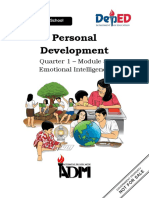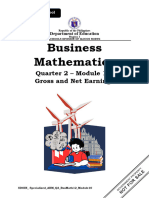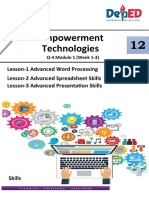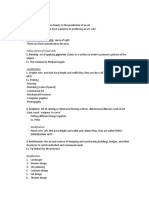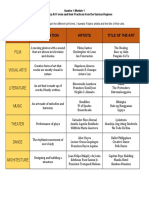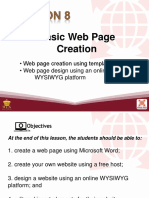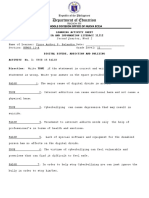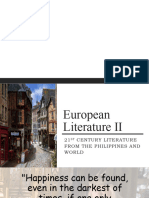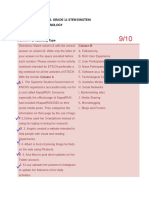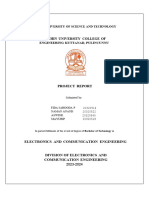Q2 Week 2 - Imaging and Design For Online Environment
Q2 Week 2 - Imaging and Design For Online Environment
Uploaded by
Aura Lee CarismaCopyright:
Available Formats
Q2 Week 2 - Imaging and Design For Online Environment
Q2 Week 2 - Imaging and Design For Online Environment
Uploaded by
Aura Lee CarismaOriginal Description:
Original Title
Copyright
Available Formats
Share this document
Did you find this document useful?
Is this content inappropriate?
Copyright:
Available Formats
Q2 Week 2 - Imaging and Design For Online Environment
Q2 Week 2 - Imaging and Design For Online Environment
Uploaded by
Aura Lee CarismaCopyright:
Available Formats
Republic of the Philippines
Department of Education
Name: ____________________________ Grade & Section: ___________________ Score: ____________
School: Teacher: ____________________________
Subject: Empowerment Technology
Sem/Quarter/Week: SEM 1/Quarter 2/Week 2
Lesson Topic: Evaluate existing websites and online resources based on the principles of
layout, graphic, and visual message design.
CS_ICT11/12-ICTPT-Ie-f-6
Reference/s: Empowerment Technology Modules
____________________________________________________________________________________________________________________
BASIC PRINCIPLES OF GRAPHICS AND LAYOUT
Communication is critical for people to share thoughts, feelings, and emotions. With the use of different media, people
can express their views in many ways, including adding artistic designs. The purpose of the combined images and texts
also gives influence to people not just understand the sent idea or message, but it also adds emotion to what is being
seen.
What makes a good and effective website? How do users interact with the websites they visit?
A good website must know its target audience, determine its needs, and communicate effectively using the basic
principles of graphics and layout. Users or visitors may have different interests and needs like browsing, researching,
streaming, online shopping, dating, and many others. They even behave differently depending on what they perceive on
the website. Web design matters in every user, whether they can decide to stay or just leave. Usability is important for
the users as it satisfies their experience on the website, but a good design will drag the audience’s attention to stay on
the page. Always remember that first impressions last and web design has an impact on the users on how they perceive
the brand or message.
Graphic design is an artistic way of communicating ideas and messages through visual expressions using texts, images,
and symbols. Graphic designers work on the quality of the output they serve for the audience or clients like websites,
advertisements, posters, flyers, logos, videos, and any other multimedia form. A practical graphic layout and design can
easily catch the attention of the viewers and allow them to understand the message conveniently.
Graphic Design vs. Layout
Design is a plan of creating an idea through a combination of texts, images, and other elements that are placed together
artistically, whereas, the Layout is a term used as the process of organizing and arranging these elements in a design
as you plot it in a paper.
Basic Principles of Design and Layout
1. Balance
It refers to the proper arrangement of the elements, which gives a visual weight for the design. There
are two types of balance, Symmetrical or Asymmetrical. Symmetrical balance is where the elements are
equally distributed on both sides of your design, technically a mirror-based design. In contrast,
Asymmetrical balance is a free layout where the elements can be placed in any order or the opposite of
symmetrical.
Address: Octavio Vill., Brgy. Cannery Site, Polomolok, South Cotabato
Facebook Account: Aura Lee
Contact Number: 09076916691
Email Address: miletech304560@gmail.com
Republic of the Philippines
Department of Education
2. Emphasis
It refers to something that needs to stand-out or emphasize. When working on emphasis, you can
change the color, size, or even the element itself to lead the eye to the focal interest.
3. Pattern, Repetition and Rhythm
The use of repetitive elements such as lines, shapes, forms, textures, space, colors, font, style, and the
like to create texture, movement, continuity, and consistency of the design. It also makes the design
formal and more comfortable to read because of its uniformity.
Address: Octavio Vill., Brgy. Cannery Site, Polomolok, South Cotabato
Facebook Account: Aura Lee
Contact Number: 09076916691
Email Address: miletech304560@gmail.com
Republic of the Philippines
Department of Education
4. Alignment
It refers to the proper placement of an element to your design, just like invisibly placing or aligning your
texts or images diagonally, vertically, and horizontally. The standard texts or paragraph alignment we
apply are center, right, left, and justified.
5. Hierarchy
It refers to the proper arrangement of the details such as text, characters, numbers, and symbols.
Changing its character size, thickness, spaces, or even font type to stand out is its most critical features.
By applying this principle, it can help the viewer to recognize and navigate the highlight of the event
smoothly.
6. Contrast
It refers to the use of different or opposite elements such as sizes (large or small), shapes (geometric or
organic), spaces (negative or positive), form (real or abstract), colors (monochromatic, complementary,
triadic, tetradic), texture (smooth or rough), and values (light or dark). The contrast gives visual weight
to an object or design. You must consider and limit the use of different elements, color, style, and
Address: Octavio Vill., Brgy. Cannery Site, Polomolok, South Cotabato
Facebook Account: Aura Lee
Contact Number: 09076916691
Email Address: miletech304560@gmail.com
Republic of the Philippines
Department of Education
typography to avoid cluttered design. When creating contrast in color and text, it is advised to choose
a color from the background to create consistency of your design. Always remember that the details
must be readable by having a dark-light value of either text and background or vice-versa.
7. Unity and Harmony
It refers to the relationship of the elements or the contents when you place them together. The elements
of the design must work together and agree to its meaning, theme, feeling, or mood.
ACTIVITY 2: Choose the letter of the best answer. Write the chosen letter on a separate sheet of paper.
1. Monochromatic uses one color in a design. Its advantage is to create balance and to match the color in an artwork.
However, this may lack energy and may look monotonous. How will you use the monochromatic scheme to create
variations?
A. Use complementary colors C. Change the hue of the artwork or every
B. Adjust the saturation and value element
D. Choose a design that is more suitable for the
color scheme used
2. What is the purpose of creating a hierarchy in your design?
A. It gives consistency. C. To add beauty to the design.
B. It adds visual weight. D. Make the detail to stand out.
3. Which of the following refers to the plan of creating an idea through a
combination of texts, images, and other elements that are placed together
artistically?
A. Design C. Graphic
B. Layout D. Message
4. Which principle of design is when a designer arranges the elements or
text according to its context?
A. Balance C. Emphasis
B. Harmony D. Hierarchy
5. Which type of balance gives a mirror-like design that is proportionally equal
to the other side?
A. Asymmetrical C. Symmetrical
B. Semi-Balance D. Semi-Proportion
Address: Octavio Vill., Brgy. Cannery Site, Polomolok, South Cotabato
Facebook Account: Aura Lee
Contact Number: 09076916691
Email Address: miletech304560@gmail.com
Republic of the Philippines
Department of Education
6. Contrast refers to the use of different or opposite elements such as sizes, shapes, spaces, forms, colors, and values
in design. Which of the designs below show the least application of contrast in a design?
7. Which of the principles of graphics and layout refers to the proper arrangement of elements, which gives a visual
weight for the design?
A. Balance C. Emphasis
B. Pattern, Repetition and Rhythm D. Unity and Harmony
8. As a layout artist, we must know the details in arranging and accentuating the most important terms by changing its
size, thickness, and spaces so the reader can navigate the highlight of the event easily. Which of the following principles
best describe the statement above?
A. Alignment C. Contrast
B. Hierarchy D. Pattern, Repetition and Rhythm
9. The following are the ways where you can emphasize the text if you are working on a magazine except:
A. By changing the font color C. By adding illustrations or images
B. By making the text bold or italic D. By changing the font size, either bigger or
smaller
10. What other elements of design can be repeated aside from color, header style, and fonts?
A. Paper C. Size
B. Statement D. Word
REFLECTION: The layout is the part of graphic design that deals in the arrangement of visual elements on a page. It
generally involves organizational principles of composition to achieve specific communication objectives. Write a
reflection based on what you have learned on this topic. You may do any of the following methods to express your
thoughts. Choose any method of writing your reflection from the box and write it on a piece of paper.
_______________________________________________________________________________________________
_______________________________________________________________________________________________
_______________________________________________________________________________________________
Address: Octavio Vill., Brgy. Cannery Site, Polomolok, South Cotabato
Facebook Account: Aura Lee
Contact Number: 09076916691
Email Address: miletech304560@gmail.com
Republic of the Philippines
Department of Education
ADDITIONAL ACTIVITIES: Browse the given websites listed below and evaluate the layout and design of their pages
using the Web Design Assessment Checklist. Place a checkmark (/) on the Yes or No column that corresponds to each
question. Add comments or suggestions for a detailed description in each number. Grab and paste a screenshot of your
every page to be evaluated. Do it in a separate sheet. (40 points)
Write your answer in a separate sheet of paper. You are expected to submit 5 Website Design Assessment Checklists.
1. https://www.deped.gov.ph
2. https://education.minecraft.net
3. https://teachforthephilippines.org
4. https://arvr.google.com/ar
5. https://www.canva.com
You will be rated according to this rubric:
Address: Octavio Vill., Brgy. Cannery Site, Polomolok, South Cotabato
Facebook Account: Aura Lee
Contact Number: 09076916691
Email Address: miletech304560@gmail.com
You might also like
- Te0042 Jacquard Design in Photoshop - BasicsDocument2 pagesTe0042 Jacquard Design in Photoshop - Basicsবিশ্বজিৎ বিশ্বাস100% (3)
- 2nd QuarterDocument40 pages2nd QuarterSayme WPNo ratings yet
- Principles-and-Strategies-of-Teaching-Lecture MPAS PDFDocument200 pagesPrinciples-and-Strategies-of-Teaching-Lecture MPAS PDFrotsacreijav6666690% (10)
- Laser Engraving Manual PDFDocument21 pagesLaser Engraving Manual PDFarturo0diaz_1No ratings yet
- Sample Food Business Plan Oklahoma StateDocument61 pagesSample Food Business Plan Oklahoma StateJuvvilyynGraceMahomatNo ratings yet
- Entrepreneurship Module 5Document11 pagesEntrepreneurship Module 5Jester Fermalino AquinoNo ratings yet
- Math 12-ABM Org - Mgt-Q1-Week-8Document20 pagesMath 12-ABM Org - Mgt-Q1-Week-8Nice D. ElseNo ratings yet
- Cpar SLM 3 Contemporary Arts From The Philippines Salud Publica Dependencia y Trabajo SocialDocument24 pagesCpar SLM 3 Contemporary Arts From The Philippines Salud Publica Dependencia y Trabajo SocialEann CordovaNo ratings yet
- Cesc12 2nd-Sem Q3 Module-2Document25 pagesCesc12 2nd-Sem Q3 Module-2Jennifer Lawas AbenazaNo ratings yet
- Contemporary Arts 12 Q2 M4Document13 pagesContemporary Arts 12 Q2 M4Gabriel Laureano EugenioNo ratings yet
- Quarter 2 - Week 4: Media and Information LiteracyDocument14 pagesQuarter 2 - Week 4: Media and Information LiteracyedzNo ratings yet
- UCSP Quarter 2 Module 9Document10 pagesUCSP Quarter 2 Module 9reymarkpalaca31No ratings yet
- History of Brgy IrironDocument3 pagesHistory of Brgy IrironGIEBON QUIROSNo ratings yet
- The Evolution of Traditional To New Media - The Evolution of Media, Functions of Media, Media and The GovernmentDocument24 pagesThe Evolution of Traditional To New Media - The Evolution of Media, Functions of Media, Media and The GovernmentEmarkzkie Mosra OrecrebNo ratings yet
- Mil Q3W6Document14 pagesMil Q3W6Alexa RomarateNo ratings yet
- Lesson-3.3-Industry-Analysis (Ogania-Tuazon)Document11 pagesLesson-3.3-Industry-Analysis (Ogania-Tuazon)Andrea Nicole HernandezNo ratings yet
- Oralcom Quarter2 Module 9 2.5Document13 pagesOralcom Quarter2 Module 9 2.5Albern Ray Balean100% (1)
- Eng10 Q3 Module2aDocument19 pagesEng10 Q3 Module2aChelle VillasisNo ratings yet
- Various Contemporary Art Forms andDocument62 pagesVarious Contemporary Art Forms andRoselyn L. Dela CruzNo ratings yet
- Module 4bDocument17 pagesModule 4bJay BaliarNo ratings yet
- What I Know .: Directions: Choose The Letter of The Correct Answer. Write The Chosen Letter On A Separate Sheet of PaperDocument17 pagesWhat I Know .: Directions: Choose The Letter of The Correct Answer. Write The Chosen Letter On A Separate Sheet of PaperDave Mark OlaguirNo ratings yet
- EmpTech11 Q1 Mod4Document28 pagesEmpTech11 Q1 Mod4Kristine Jubilado100% (1)
- NegOr Q3 EAPP Module3 v2Document18 pagesNegOr Q3 EAPP Module3 v2mattrusselteves011No ratings yet
- Q1 Entrepreneurship M6-1Document20 pagesQ1 Entrepreneurship M6-1karelleasmad6No ratings yet
- Module 3 Lessons 3 4Document30 pagesModule 3 Lessons 3 4Pereyra Faith AngeliqueNo ratings yet
- Module in Reading and Writing Q2-Q4 Week 4Document10 pagesModule in Reading and Writing Q2-Q4 Week 4Krizia BreganiaNo ratings yet
- MIL Q2 Module4 EditedDocument14 pagesMIL Q2 Module4 EditedAljun MisaNo ratings yet
- Understanding Culture, Society, and Politics: Concepts of Sociology, Anthropology, and The Study of CultureDocument14 pagesUnderstanding Culture, Society, and Politics: Concepts of Sociology, Anthropology, and The Study of CultureLyka Niña PasonNo ratings yet
- MODULE 2 With AnswerDocument11 pagesMODULE 2 With AnswerLielanie NavarroNo ratings yet
- Applied Economics 2Document14 pagesApplied Economics 2Johnwilliam PluralNo ratings yet
- Practical Research 2 Q4 SLM6Document16 pagesPractical Research 2 Q4 SLM6Gwen GwenNo ratings yet
- Week 8 SLM Perdev 12Document29 pagesWeek 8 SLM Perdev 12Christian Jeremy ManaloNo ratings yet
- Assessment M6Document1 pageAssessment M6Reign PedrosaNo ratings yet
- Entrepreneurship: Quarter 1Document13 pagesEntrepreneurship: Quarter 1Chie ValdezNo ratings yet
- PPG q1 Mod5 Evolution of Philippine Politics Governance 1Document33 pagesPPG q1 Mod5 Evolution of Philippine Politics Governance 1AirakawaiiNo ratings yet
- Quarter 2 Module 3 Contemporary Art Ver3Document13 pagesQuarter 2 Module 3 Contemporary Art Ver3Jenny SeitonNo ratings yet
- TOSEND BusMath Q2 Mod10 W3 Gross-And-Net-EarningsDocument18 pagesTOSEND BusMath Q2 Mod10 W3 Gross-And-Net-EarningsAidalyn RagonjanNo ratings yet
- Empowerment Technologies-TVL/GAS Module 5Document12 pagesEmpowerment Technologies-TVL/GAS Module 5Chantelle ObnascaNo ratings yet
- Lesson 1 - Contemporary Art Forms and Practices From The RegionsDocument15 pagesLesson 1 - Contemporary Art Forms and Practices From The RegionsOMIER YASINNo ratings yet
- Empowerment Q 4 Module 1 3 Week 1 and 3Document31 pagesEmpowerment Q 4 Module 1 3 Week 1 and 3Jernel RaymundoNo ratings yet
- FINAL Contemporary Arts Week 1 For StudentDocument12 pagesFINAL Contemporary Arts Week 1 For StudentlayancrystalynNo ratings yet
- Set A Exam in PE 1st QRTRDocument5 pagesSet A Exam in PE 1st QRTRRuth PerezNo ratings yet
- Grade 12 Shs Hope q2 m1Document17 pagesGrade 12 Shs Hope q2 m1FefeNo ratings yet
- CPARDocument6 pagesCPARJacqueline DonatoNo ratings yet
- Emp Tech - Q1 - M1.1 - ICT and Its Current StateDocument11 pagesEmp Tech - Q1 - M1.1 - ICT and Its Current StateBurnt OutNo ratings yet
- Perdev12 Q2 M8Document9 pagesPerdev12 Q2 M8JHONERICA MOZONNo ratings yet
- Organization-and-Management Q2 M9 PRINTED2021NOV18Document19 pagesOrganization-and-Management Q2 M9 PRINTED2021NOV18Jade ivan parrochaNo ratings yet
- Imaging and Design For Visual Message Using Infographics: LAS For Empowerment Technologies (Grade 11)Document3 pagesImaging and Design For Visual Message Using Infographics: LAS For Empowerment Technologies (Grade 11)rosellerNo ratings yet
- Art Forms Explanation Artists Title of The ArtDocument1 pageArt Forms Explanation Artists Title of The ArtSophia KimbleNo ratings yet
- Perdev12 Q3 M2Document24 pagesPerdev12 Q3 M2Sodium ChlorideNo ratings yet
- Organization-And-Management Q2 M16 PRINTEDon01!14!2022ready4nextDistnDocument17 pagesOrganization-And-Management Q2 M16 PRINTEDon01!14!2022ready4nextDistnJade ivan parrochaNo ratings yet
- Media & Information Literacy Module 1 PDFDocument20 pagesMedia & Information Literacy Module 1 PDFJaymel Jinon Eiman100% (1)
- L8 Basic Webpage CreationDocument7 pagesL8 Basic Webpage CreationCrystal Gayle BadingNo ratings yet
- Learning Activity Sheet Media and Information Literacy 11/12Document4 pagesLearning Activity Sheet Media and Information Literacy 11/12Vince Andrei BalandraNo ratings yet
- Applied Economics 10Document20 pagesApplied Economics 10Nelia Pecaso MillionNo ratings yet
- Omeroom Guidance: Quarter 1 - Module 2: Life in Harmony With OthersDocument10 pagesOmeroom Guidance: Quarter 1 - Module 2: Life in Harmony With OthersCindy De OcampoNo ratings yet
- Empotech Module 3Document4 pagesEmpotech Module 3markfrancismalazarteNo ratings yet
- First Week Module - Intro To ServerDocument20 pagesFirst Week Module - Intro To ServerLinger Faith Eyawon Mayor-MoralesNo ratings yet
- Lesson 6 ICT As Platform For Change: TopicsDocument5 pagesLesson 6 ICT As Platform For Change: TopicsRose Kimberly Bagtas Lucban-Carlon50% (2)
- European-Literature-Q2 Archetypes RepportDocument36 pagesEuropean-Literature-Q2 Archetypes RepportPrinces Shane GioNo ratings yet
- Emtech Q1 Las Week 8 (2021-2022)Document5 pagesEmtech Q1 Las Week 8 (2021-2022)rosellerNo ratings yet
- Week 6 - Empowerment TechnologyDocument17 pagesWeek 6 - Empowerment TechnologyMyleen CastillejoNo ratings yet
- EmTech Week5Document11 pagesEmTech Week5Crisanto CorpuzNo ratings yet
- 2023 1st QTR ETECH Item Analysis - Frequency of ErrorsDocument2 pages2023 1st QTR ETECH Item Analysis - Frequency of ErrorsAura Lee CarismaNo ratings yet
- DM Cid No. 204, S. 2024-Finalist For The 2024 Final National Music Competition For Young Artists (Namcya)Document3 pagesDM Cid No. 204, S. 2024-Finalist For The 2024 Final National Music Competition For Young Artists (Namcya)Aura Lee CarismaNo ratings yet
- 2023 COT (Second Quarter)Document5 pages2023 COT (Second Quarter)Aura Lee Carisma100% (1)
- Regional Memorandum Clmd-2024-355 Addendum To Region Memorandum CLMD 2024-311 Participation To 2024 Namcya - Salinlahing MusikaDocument1 pageRegional Memorandum Clmd-2024-355 Addendum To Region Memorandum CLMD 2024-311 Participation To 2024 Namcya - Salinlahing MusikaAura Lee CarismaNo ratings yet
- 2024 Letter TagumDocument6 pages2024 Letter TagumAura Lee CarismaNo ratings yet
- Hrpta Meeting ReportsDocument8 pagesHrpta Meeting ReportsAura Lee CarismaNo ratings yet
- Q4-W1 Network Topology PDFDocument4 pagesQ4-W1 Network Topology PDFAura Lee CarismaNo ratings yet
- Q1 Week 4 - Computer Software - Application SoftwareDocument3 pagesQ1 Week 4 - Computer Software - Application SoftwareAura Lee CarismaNo ratings yet
- 1.2 Knowing OneselfDocument18 pages1.2 Knowing OneselfAura Lee CarismaNo ratings yet
- Q2 Week 2 - Maintain Computer Equipment and SystemDocument3 pagesQ2 Week 2 - Maintain Computer Equipment and SystemAura Lee CarismaNo ratings yet
- 2.1 Five Areas of DevelopmentDocument24 pages2.1 Five Areas of DevelopmentAura Lee CarismaNo ratings yet
- Q1 Week 2 - Assemble Computer HardwareDocument3 pagesQ1 Week 2 - Assemble Computer HardwareAura Lee Carisma100% (1)
- 2.2 Thoughts, Feelings and BehaviorDocument20 pages2.2 Thoughts, Feelings and BehaviorAura Lee CarismaNo ratings yet
- Alim, Angel Nicole B. Grade 11 Stem Einstein Empowerment TechnologyDocument5 pagesAlim, Angel Nicole B. Grade 11 Stem Einstein Empowerment TechnologyAura Lee CarismaNo ratings yet
- Network TopologiesDocument27 pagesNetwork TopologiesAura Lee CarismaNo ratings yet
- False 2. True 3. False 4. False 5. True 6. True 7. True 8. True 9. True 10. FalseDocument1 pageFalse 2. True 3. False 4. False 5. True 6. True 7. True 8. True 9. True 10. FalseAura Lee CarismaNo ratings yet
- Department of Education: Empowerment TechnologiesDocument6 pagesDepartment of Education: Empowerment TechnologiesAura Lee CarismaNo ratings yet
- Bolante R. Q1W1Document3 pagesBolante R. Q1W1Aura Lee CarismaNo ratings yet
- Bautista, CarloDocument3 pagesBautista, CarloAura Lee CarismaNo ratings yet
- Diagram, Information: and 2/quarter Lesson and Similarities Information and 2 andDocument1 pageDiagram, Information: and 2/quarter Lesson and Similarities Information and 2 andAura Lee CarismaNo ratings yet
- Diagram, Information: and 2/quarter Lesson and Similarities Information and 2 andDocument1 pageDiagram, Information: and 2/quarter Lesson and Similarities Information and 2 andAura Lee CarismaNo ratings yet
- Beginners Guide To BlenderDocument18 pagesBeginners Guide To Blenderfoster chidambaNo ratings yet
- Computer Graphics With Opengl: Outline Philosophy Composition Recommended ReadingDocument15 pagesComputer Graphics With Opengl: Outline Philosophy Composition Recommended ReadingB.TulasiNo ratings yet
- PUBG BG Brand Guidelines 2021Document59 pagesPUBG BG Brand Guidelines 2021thekuansinNo ratings yet
- Gallagherbrandguidelines 01-2022Document72 pagesGallagherbrandguidelines 01-2022Amol TiwariNo ratings yet
- Mil Q2 M5 M6 - Mil Mil Q2 M5 M6 - Mil: Nursing (University of Pangasinan) Nursing (University of Pangasinan)Document25 pagesMil Q2 M5 M6 - Mil Mil Q2 M5 M6 - Mil: Nursing (University of Pangasinan) Nursing (University of Pangasinan)Eann CordovaNo ratings yet
- Stefanov Nikolay DeferredRadianceTransferDocument63 pagesStefanov Nikolay DeferredRadianceTransferDaniel JuniorNo ratings yet
- Utopia Project Rubric UseDocument2 pagesUtopia Project Rubric Useapi-515451441No ratings yet
- Job Applicataion LetterDocument3 pagesJob Applicataion LetterM Fery KlisanaNo ratings yet
- computer-graphics-2023Document2 pagescomputer-graphics-2023Salim AnsariNo ratings yet
- SyncconversionDocument1 pageSyncconversiontshbsatelliteNo ratings yet
- Modul 6 GrafKom-Atribut Output PrimitiveDocument29 pagesModul 6 GrafKom-Atribut Output PrimitiveJajang Mochamad MimbarNo ratings yet
- Ict SHSDocument5 pagesIct SHSGretel T RicaldeNo ratings yet
- 3dtotalmodelado de Juana de Arco PDFDocument799 pages3dtotalmodelado de Juana de Arco PDFCuchillo111No ratings yet
- Evermotion Hdmodels Cars Vol 4 PDFDocument2 pagesEvermotion Hdmodels Cars Vol 4 PDFMichelleNo ratings yet
- E TechDocument9 pagesE TechAlle SwiftNo ratings yet
- Lecture 04 Matlab PDFDocument25 pagesLecture 04 Matlab PDFApichat JunsodNo ratings yet
- Tip 1Document2 pagesTip 1marie-joNo ratings yet
- S.Y.B.sc. (IT) Sem - III - Paper - II - Computer GraphicsDocument144 pagesS.Y.B.sc. (IT) Sem - III - Paper - II - Computer GraphicsRula ShakrahNo ratings yet
- Teaching Arts in Elementary Grades - Elements of Visual Arts: ColorDocument37 pagesTeaching Arts in Elementary Grades - Elements of Visual Arts: ColorJorielyn ApostolNo ratings yet
- GTL Ver4Document718 pagesGTL Ver4kmeena73100% (1)
- ETECHmodule Week 1-4Document18 pagesETECHmodule Week 1-4Ralph John Basingan TenorioNo ratings yet
- IrfanView - Wikipedia, The Free EncyclopediaDocument4 pagesIrfanView - Wikipedia, The Free EncyclopediaHarry MichaelNo ratings yet
- Color Checker Passport Profile InstructionsDocument4 pagesColor Checker Passport Profile InstructionsoxsNo ratings yet
- OCR Level 3 Cambridge Technical in Business: (Student)Document10 pagesOCR Level 3 Cambridge Technical in Business: (Student)Wajeeha SaleemNo ratings yet
- 1.2 MultimediaDocument55 pages1.2 Multimediakoimin203No ratings yet
- MmlabDocument39 pagesMmlabrushi kolliNo ratings yet
- 7thapril-Project Repo FINALDocument68 pages7thapril-Project Repo FINALNishanth NishNo ratings yet































